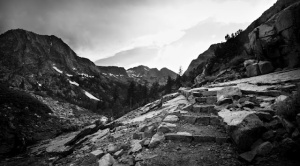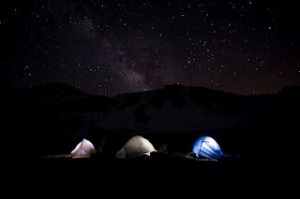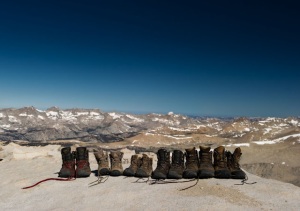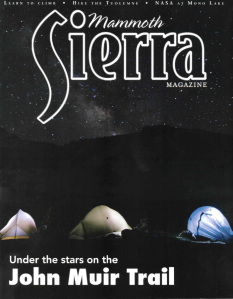The Muir Project:
There’s Some Inspiring Scenery Up in the Sierras, and a Trail Runs Through It.
by Michael Koehn
“Wander a whole summer if you can. If you are business-tangled and so burdened by duty that only weeks can be got out of the heavy laden year, give a month at least. The time will not be taken from the sum of life. Instead of shortening, it will indefinitely lengthen it and make you truly immortal.”
– John Muir
It’s no secret that the John Muir Trail, a hiking destination that runs that for over 200 miles from Yosemite’s valley floor through the Ansel Adams Wilderness, Sequoia National Park, Kings Canyon National Park and ends at the top of Mt. Whitney, wends through some of the most spectacular wilderness in the world. The trail covers much of the scenic splendor of the high Sierras, and is well-documented by outdoor enthusiasts who travel from around the world to hike the JMT.
In the summer of 2011, a group of southern California-based multimedia artists decided to take the documentation to a whole new level, venturing through Muir’s Sierras, which he called “The Range of Light,” and capturing the experience in a variety of creative formats, including still photography, HD video, digital audio, music and painting, all part of a concept they call The Muir Project.

“It was an idea I had been kicking around for about ten years,” says Jason Fitzpatrick, who was one of the team’s co-directors and serves as a director of photography for the project. “I had worked with everyone in the group on some creative level, and they were also avid outdoor enthusiasts, so we kept talking about the JMT as a creative project, trying to come up with an idea that would combine our artistic talents and love of the outdoors.”
Eventually Jason teamed up for some backpacking with Ric and Jen Serena, creative artists who also shared Jason’s love of wilderness, and they discussed the idea of doing something on the JMT. “Every winter for the past five years, Jason had reminded us ‘we should really try and do Muir this year,’ and we finally decided it would be great to use some of the latest HD technology and just get out there and get some really amazing shots of the area,” Ric Serena says.
Over time, the idea began to take on a life of its own and more people got involved, expanding the scope of the project into something that would be far more encompassing and ambitious than just taking high definition nature shots. Soon Jason, Ric and Jen had been joined by location sound recordist Durand Trench, musician Paul Bessenbacher, and cameraman Zee Hatley. Over the course of their hike, covering 230 miles from July 10 to August 3, 2011, they met up with and were joined by musicians, painters and other adventure-seekers, who all became part of the story, including musician Bernard Chadwick and David and Kelly Finlay, teachers out of Colorado.
“We wanted to create an experience that would encompass a lot more than just pretty images,” photographer Jen Serena says. “One of the goals was to get out there and try to capture not only the beauty of hiking the trail, but also to capture something of the human experience, the enjoyment of being surrounded by like-minded people who valued the experience as much as you did.”
What was to become The Muir Project was originally conceived as an exhibition that would use a variety of multi-media displays, re-creating moments along the trail and allowing people to actually experience a little of what hiking the JMT is like, without the blisters.

Although the multi-media exhibition was the first idea that came to mind, the idea of a documentary film quickly became the project that everyone gravitated to. “We had no idea how to curate an art exhibit, but knew we had the resources and the abilities to make a video documentary happen,” Jen Serena says. “So we decided to tackle that project first, create a fan base and then follow it up with an exhibition.”o become The Muir Project was originally conceived as an exhibition that would use a variety of multi-media displays, re-creating moments along the trail and allowing people to actually experience a little of what hiking the JMT is like, without the blisters.
So the core group, laden with backpacks bulging with audio/video gear, including a Nikon D3S, Nikon D7000, Canon Vixia HF10, GoPro HD, Jason’s Canon 5D Mark II, Durand’s portable digital audio recorder and Sennheiser mics and a Goal Zero Elite solar panel, began the journey up into the topography above 10,000 feet where Muir found his bliss.
It’s a place essentially unchanged from the way it has been for hundreds of thousands of years, with a few exceptions. “Even in the most remote areas of the Sierras you cannot escape noise pollution from air traffic,” Durand explains. “Keeping that in mind I try to catch moments along the trail, such as frogs having a conversation with each other or resting in a grove of aspens with a light breeze rolling through. These are the sort of moments I truly enjoy reliving when I’m sitting at home and trying to escape the incessant drone of leaf blowers.”
In 2011, snowpack for the year was the heaviest in recent memory, and for while it looked like the venture might be ill-fated. “It was touch and go there for a while as to whether we would be able to do the trip at all due to the heavy snowpack,” Jen says. “We were just 2-3 days into the trip and were meeting hikers on the trail coming back who had turned around and were quitting. We were hearing things from other hikers and rangers about dangerous creek crossing at many points on the trail.”
It says something about the camaraderie of the group that, despite the physical challenges and the burden of twenty extra pounds of tech gear, everybody got through without a mishap, except the temporary loss of a pair of sandals. Finding it admittedly difficult at times, the Muir team plunged into the experience of the trail and the sweeping landscape that surrounds it, stopped to film and paint, carrying gear and artwork over passes, across rivers, through clouds, down sun-cupped snow fields and finally up to the highest peak in the continental U.S. at 14,456 feet, Mt. Whitney.

“Before the JMT, I tried to hit the trails as much as possible to get prepped,” Jen explains. Another big goal of mine was to memorize the different yoga positions I practiced with my instructor every week so I could duplicate them on the trail. Before and after every hike, I did a few poses. Balancing on smooth angled rocks, gravel floor and wobbly legs was just an added part of the adventure. Without a single doubt that kept me feeling good the entire time on the trail. Even carrying almost 50 pounds on my back up those passes, it never hurt.”
The team’s creative philosophy was based on thoroughly immersing themselves in the overall experience, and then documenting their feelings in as many ways as possible. “We weren’t a fast group,” says co-director and director of photography Ric Serena. “Let’s just get that out of the way. We’d made it our mission to capture the essence of the trail and its surroundings, and that required a substantial amount of time and energy each day. On top of that, we’d all arranged to be gone for 25 days and there was very little need to shorten that by even an hour. If I could do it all over again, I’d allow myself more time to shoot and not be so worried about making it to camp before dark every night.”
Indulgences along the trail had to be taken where they could be found. Bathing usually consisted of brief plunges into 45-degree lakes, and that happened consistently with each new body of water encountered. Snow covered passes were an opportunity for some impromptu tobogganing, and bears, potato-eating marmots, blisters and borderline insane creek crossings were constant occurrences along the way.
“I’m not going to lie, there were a few crossings that were a little higher and swifter than I would have liked,” Jason says. “Often you would see the rocky edge of a trail one or two feet underwater. “That said, the snow and the water made this an extraordinary year to hike the JMT. You might get one year like that out of every twenty to thirty.”
The group’s running joke on the trail was that the next destination was only a mile, mile and a half away, which became the working title for the documentary. Most days they covered at least 10 miles and elevation changes of around 2,000 feet. One of the true pleasures for the group was the evening meal and campfire, an atmosphere brightened by the ukulele skills of musician Paul Bessenbacher of Opus Orange. His upbeat music serves as the signature sound for the video trailer.
“It’s hard to choose a single special moment in what was really a special trip all around,” explains Jason, “but when I think of what we called ‘Starbucks Pass’ I remember a humorous moment among the many we had on the hike. There isn’t a pass named for the ubiquitous coffee chain, that’s just what we named a pass near Garnet Lake. Once we finally reached the top of the ridge and could see the trail ahead, it was snow free and we unexpectedly had great cell phone reception. Everyone took the opportunity to call friends and family, and Ric and Jen got to talk to their daughter. As I looked at the group all chatting away on our phones, it reminded me of a Starbucks back home in LA, so it will live forever in my mind as ‘Starbucks Pass’.”
After the group finally crested Mt. Whitney the real work began. They had accumulated over 30 hours of video footage (about 2TB once everything has been converted to ProRes) and thousands of still photos, and it would take months to sift through the wealth of imagery they had captured. The goal now is to take that extraordinary footage and edit it into a documentary of about 90 minutes that creatively expresses a month-long wilderness adventure, both visually and aurally.
“Now that we’ve put away the heavy gear we’re continually working on a blog updating the progress of the full length documentary and eventually an interactive exhibit. We hope to have a lot of things to share from this trip,” Jason says.
The plan is to take the completed film out to key independent film festivals and find wider distribution. Eventually a fully-packaged DVD will be produced.
The Muir Project is an example of what can happen when creative, like-minded people decide to collectively share something that is rooted in a common human experience, in this case something that is directly connected to the reverence John Muir had for the Sierras. The team made it through with just a few cuts, scrapes and blisters, and our reward is that they are now in the process of creating something special about a revered place to share with us all.
For more information on The Muir Project:
Trailer: http://vimeo.com/36675195
Trail head: http://www.themuirproject.com
